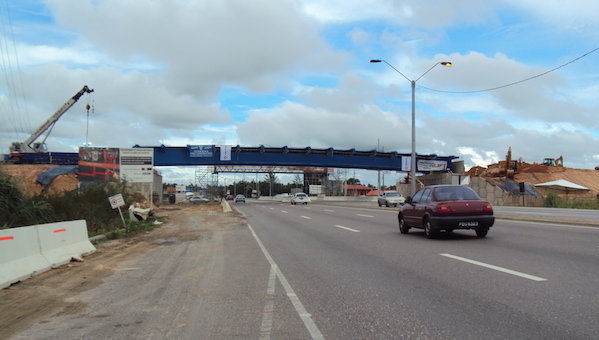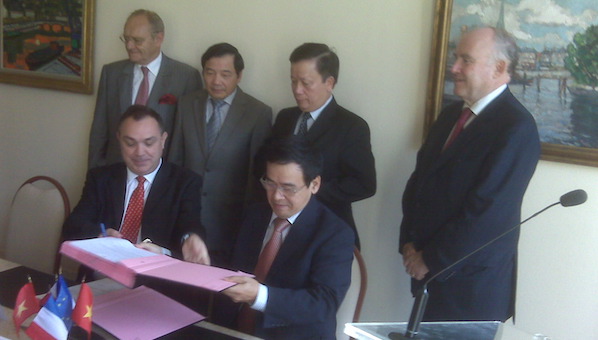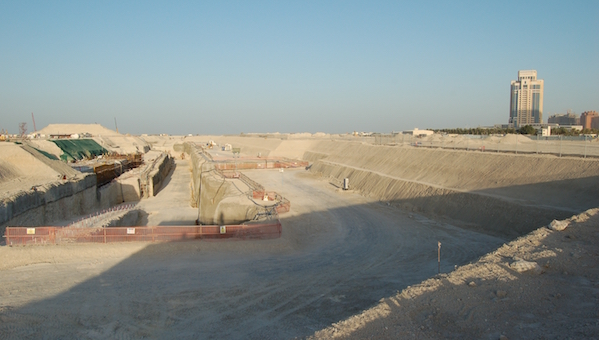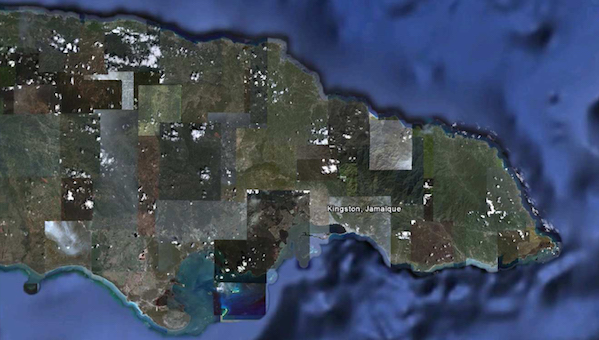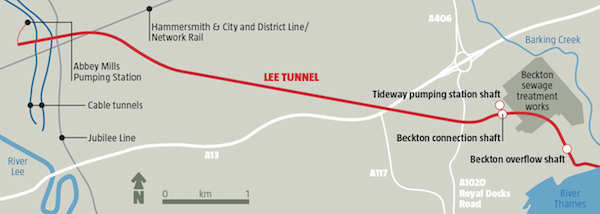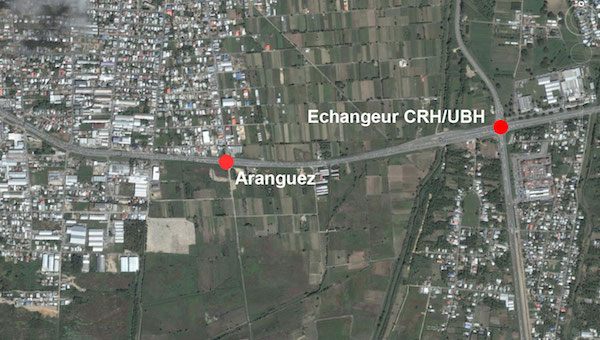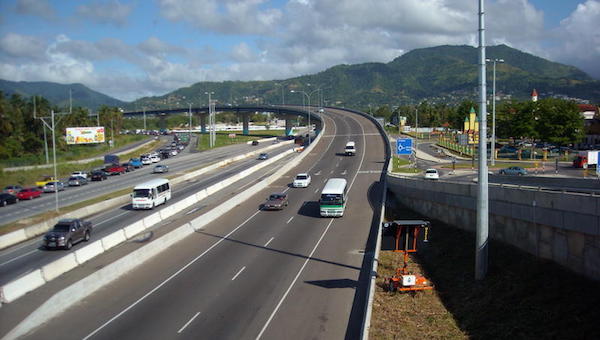In attendance for this operation were: Jack Warner, the Minister of Works and Transport of Trinidad and Tobago, Michel Trinquier, the Ambassador of France, and Nirad Ramrekersingh, President of NIDCO (the client).
This impressive steel structure, preassembled in two months on the north embankment, was erected over the highway in 20 minutes using 4 Self Propelled Electronic trailers and installed over 4 seismic designed bearings. The operation, from start to finish, only required 4 hours, from 8 pm to midnight, allowing to re-open the highway to traffic six hours ahead of schedule.
The Aranguez Flyover will improve the flow of traffic on Churchill Roosevelt Highway from the capital, Port of Spain, to San Fernando as well as reduce traffic congestion as a whole on the island of Trinidad and Tobago.
The signing took place in the presence of Mr Dominique Bussereau, France’s Secretary of State for Transport, and Mr Nguyen Hong Quan, Vietnam’s Minister of Construction.
The agreement provides for a first phase of exclusive discussions with a view to signing a design-build contract.
Located on the main north-south corridor between Hanoi and Ho Chi Minh City (RN 1A), the project calls for widening 9 kilometres of road and building a new 11 km section that includes two tunnels (5.5 km and 0.350 km), three bridges with a total length of 1.260 km and approach roads totalling 4 kilometres. It will eliminate the final dangerous mountain pass crossing on the RN 1A.
The value of the project is estimated at $600 million.
In parallel, Deo Ca Investment JSC signed three other MOU: one with Egis for the studies, another with Apave for works monitoring and quality control, and the third with Crédit Agricole and Société Générale for the financing.
The contract, valued at €129 million, covers civil works of the cut-and-cover tunnels and the construction of pumping and ventilation shafts. This phase of the project will be completed in 23 months. The first phase, currently underway by QDVC, covers feasibility studies, design and earthworks.
The whole project, which is being carried in successive phases as part of an ECI arrangement (Early Contractor Involvement), calls for the design and construction of a light-rail transit system that includes 28 kilometres of lines, including 7 kilometres underground, 32 stations (7 underground), 1 viaduct with an elevated station and 1 operation and maintenance depot. The LRT system will cover the new city of Lusail as a whole and will be connected to the regional transport system in the future.
The project will be completed over a 4 year span following a third phase now under study.
The contract is worth €51 million. The work involves laying 19 km of pipes and upgrading two water treatment stations. WMI, subsidiary of VINCI Construction Grands Projets, will be responsible for optimising management of the network.
The works will start early April 2010 and will last 24 months. They will be followed by a second phase that should be definitively awarded to VINCI Construction Grands Projets before the summer of 2010.
This new project further strengthens VINCI Construction Grands Projets’ know-how in hydraulics and civil engineering outside France and, in particular, in Jamaica, where over the last eight years, the Group has constructed a drinking water treatment plant in Logwood, rehabilitated and laid new pipes for the water treatment stations of Great River and Martha Brae, optimised network yield on the NWP (North Western Parishes) project and rehabilitated wells and reservoirs in the framework of the KMA (Kingston Metropolitan Area) project.
The contract, worth a total of €476 million, calls for building a 7 kilometres tunnel for storm water and wastewater in east London.
Located 55 metres to 75 metres below ground, the tunnel will halve the 32 million cubic metres of wastewater that are discharged annually into the River Thames by collecting it at its source. The contract also calls for the construction of four large shafts, as well as supplying and installing the equipment and automation systems necessary for managing the effluent and lifting it more than 80 metres.
Work will start shortly and be completed in 2015.
This contract is part of the Thames Tideway programme, which includes the construction of a second tunnel, 32 kilometres long. Work on this tunnel is scheduled to start in 2015.
The Lee Tunnel contract strengthens VINCI’s presence in the UK, where it started operating in the early 1990s and where it generated revenue of €2.3 billion in 2008.
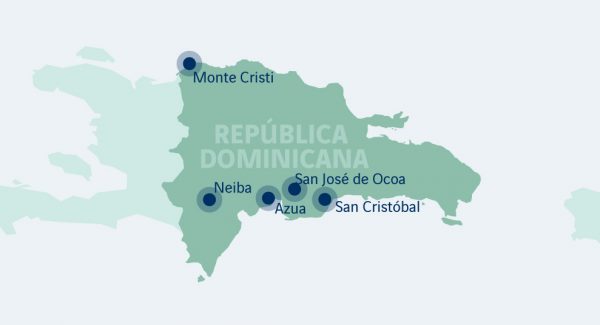
This project is part of the Dominican government’s cholera eradication programme.
The €108 million contract will be funded through €78.5 provided by the RPE (Emerging Country Reserve) fund and €29.5 million in local financing. The project involves the laying of approximately 500 km of pipes and the design and construction of eight treatment plants with population equivalent capacities ranging from 4,000 to 60,000 as well as six lifting and pumping stations. Meanwhile, an audit will be conducted with a view to improving the performance of the system and optimising the commercial service for the operator. Including six months of design studies, the works will take 42 months to complete.
These facilities comply with sustainable development criteria: simple operation, environmental protection and high-quality treatment. For example, final disinfection will take place in an ultraviolet radiation facility; its power will be supplied by photovoltaic panels, which cover 80% of overall energy requirements.
This new project confirms the expertise offered by VINCI in the international hydraulic engineering market and demonstrated by a number of recent projects: rehabilitation and extension of the drinking water system in the city of Djibouti and a water treatment plant in Kantale, Sri Lanka; improvement of the drinking water distribution and treatment system in Kingston, Jamaica; and a variety of environmental protection projects in several cities in Vietnam.
On July 28, 2009, VINCI Construction Grands Projets signed a contract worth $27.3 million with Trinidad and Tobago’s National Infrastructure Development Company (NIDCO) that calls for the design and construction of a composite bridge over the Churchill Roosevelt highway near the community of Aranguez on the island of Trinidad.
The proposed bridge is part of a firm government plan to authorize unimpeded traffic from the capital, Port of Spain, to San Fernando. The presence of the bridge will permit the removal the last remaining traffic lights at El Socorro and Aranguez. Work is set to last 16 months.
This mandate confirms the trust and confidence that NIDCO places in VINCI Construction Grands Projets following the latter’s construction of the second Churchill Roosevelt/Uriah Butler (CRH/UBH) highway interchange, which was entered into service in May 2009.

The civil engineering contract, worth €323 million, calls for building a 7.2 section of tunnel and four underground stations, which are scheduled for opening in October 2013 after 51 months of works. Eurovia Travaux Ferroviaires, a VINCI subsidiary, has been declared winner of the track contract, worth €20 million. This package calls for supplying and laying 14 km of track and power rail in the tunnel.
These new contracts reflect the confidence shown by the Egyptian Ministry of Transport in VINCI for almost 20 years. The Group built lines 1 and 2 of the Cairo metro and is currently carrying out phase 1 of line 3 (photo). Phase 1 is scheduled for completion in October 2011; 60 % of the works have been completed to date.
The first line of Cairo’s metro was built by VINCI in the early 1980s. It now carries over 2 million passengers a day. The second line (22 km) was opened in the 1990s. It has 20 stations – 12 of themunderground stations – and carries 1.8 million passengers a day.
This commercial success illustrates VINCI’s ability to execute turnkey metro projects. Apart from lines 1 and 2 of the Cairo metro, the Group’s recent prestigious references include the Budapest, Algiers, Athens, Hong Kong, Rennes and Paris (line 14) metros.
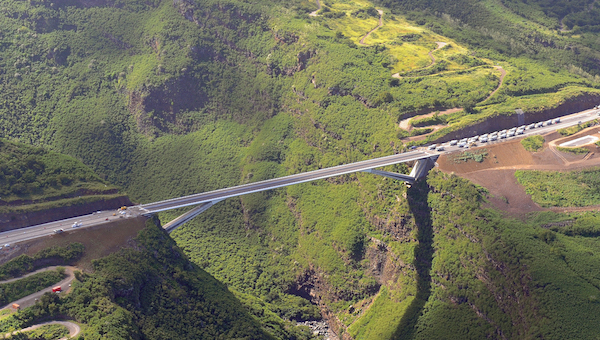
The viaduct is one of four exceptional engineering structure on the Route des Tamarins that will help relieve traffic congestion in the western part of the island. On the morning of the inauguration, residents of the neighbourhood and visitors were welcomed at the site by VINCI teams and learned about the various phases of viaduct-construction project thanks to a special exhibition. In the evening, the Grande Ravine viaduct was showcased in bright lights every half-hour, and a show bringing together 200 artists was held at the Montée Panon stadium.
This contract was entrusted to a consortium made up of VINCI Construction Grands Projets, Dodin and Eiffel. Dodin (broker) provided project management; with Freyssinet providing prestressing expertise; Deschiron, earthworks; and Eurovia, sealing. Load testing was successfully carried out in April 2009: 24 concrete-transport trucks, each weighing 30 tonnes, were positioned at specific points on the viaduct to gauge the structure’s sag.
The viaduct alone involves all the major civil engineering business lines, such as deep foundations, dam-type (single-side) formwork and cantilevering. The site itself is impressive – the Grande Ravine is 170 metres deep. Most of the stresses on the 288 metre (3,560 tonnes) steel deck are counteracted by prestresssing in the abutments. This braced bridge which consists of a metal deck resting on concrete braces must span large distances since it has 70 metre long lateral spans and a 140 metre central span.
The entry into service of Route des Tamarins is set to take place on June 23, 2009.
Located at some 10 kilometres to the east of the capital, Port of Spain, this flyover, 600 metres long and 16 metres wide, greatly improves traffic conditions by linking the main east-west (Churchill Roosevelt Highway) and north-south (Uriah Butler Highway) motorways on the island of Trinidad.
The works were undertaken by VINCI Construction Grands Projets within the framework of a €48 millions design-build contract.
The construction methods used meant this structure could be built above the country’s busiest intersection (135,000 vehicles/day) without disrupting the traffic.
